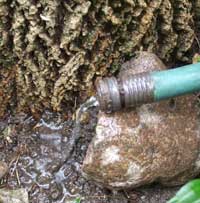8 Myths to Avoid When Watering Your Plants
Watering plants isn’t an exact science. Read this article to help you understand when to and when to not water plants.

A pencil-thin stream of water is one way to provide adequate moisture for trees in fall. © Jo Ellen Meyers Sharp
Throughout the landscape, plants are preparing for winter. The days are shorter, signaling that it’s time to drop leaves. Frost zaps many perennials back to the ground. Plants are busy storing sugars and other nutrients in their roots to sustain them through winter.
To support plants through this season of transition, make sure they get adequate water until the ground freezes. This is especially important if the summer season has been hot and dry, and for newly planted trees, shrubs and perennials.
In fall, plants do not need as much water as they may have needed in summer. But rather than stop watering altogether, it’s best to wean them from weekly watering to every other week to monthly throughout fall.
Use a soaker hose or drip irrigation system to distribute the water where it does the most good: at the root zone of the plants.
Adjust impulse sprayers to keep the spray as close to the root zones of plants as possible.
Overhead sprinklers waste a lot of water due to evaporation, but if yours is adjustable, be sure to aim it at the base of plants.
Allow a garden hose to run a pencil thin stream of water at the base of trees and shrubs for 30 minutes to an hour. This small stream of water soaks slowly and deeply in the soil to the roots.
To test how deeply the water goes, stick a trowel, spade, knitting needle or soil probe into the ground. If the tool comes out moist, measure how many inches and you’ll have an idea of how long it takes water to reach that depth. Perennials should have four to eight inches of moist soil. Shrubs and trees should have moist soil 10 to 12 inches deep.
Evergreens, such as yews, junipers, rhododendrons and hollies will thrive if they go into winter well hydrated.
Flowering trees, shrubs and perennials also tend be more vibrant in spring if they are well watered before winter.